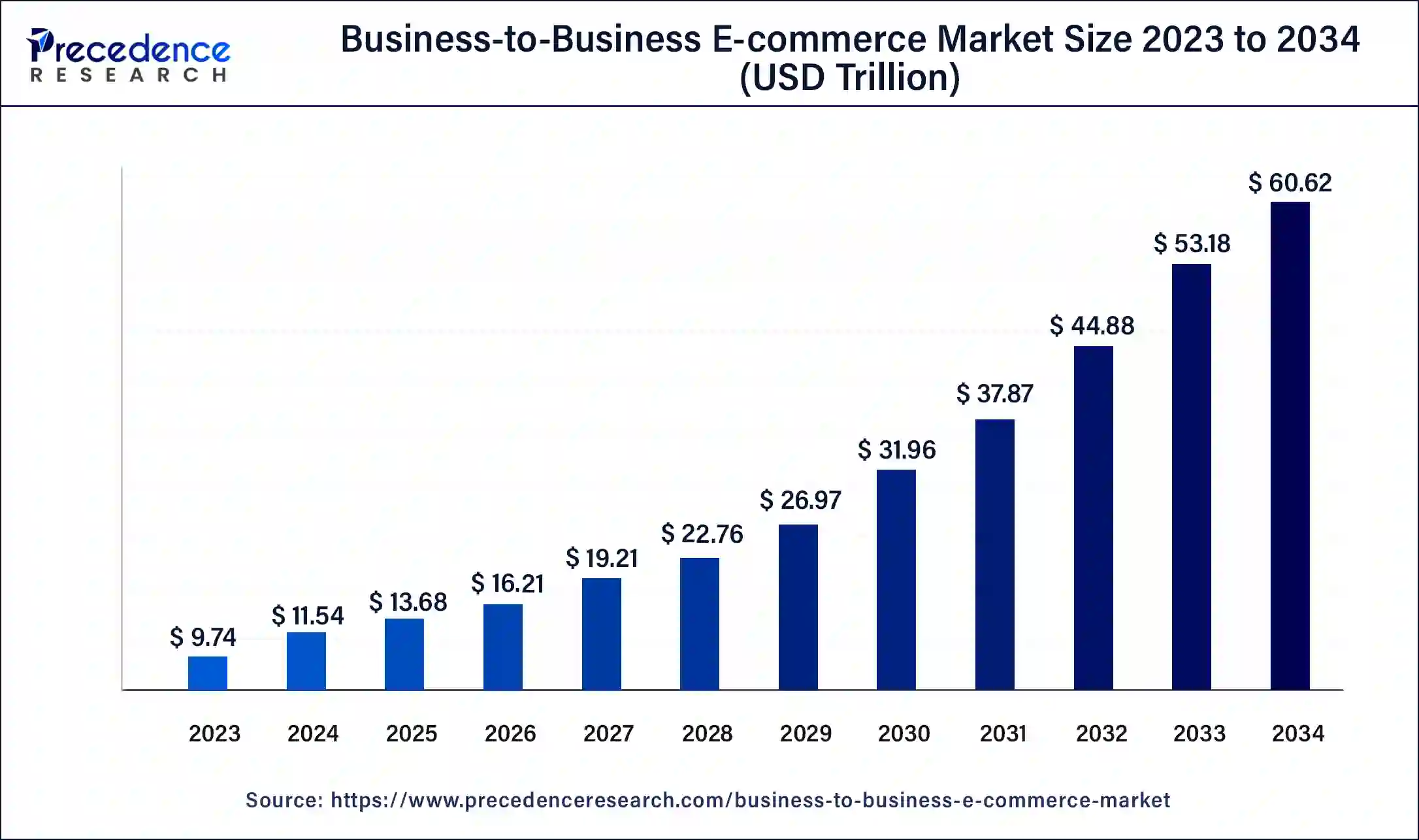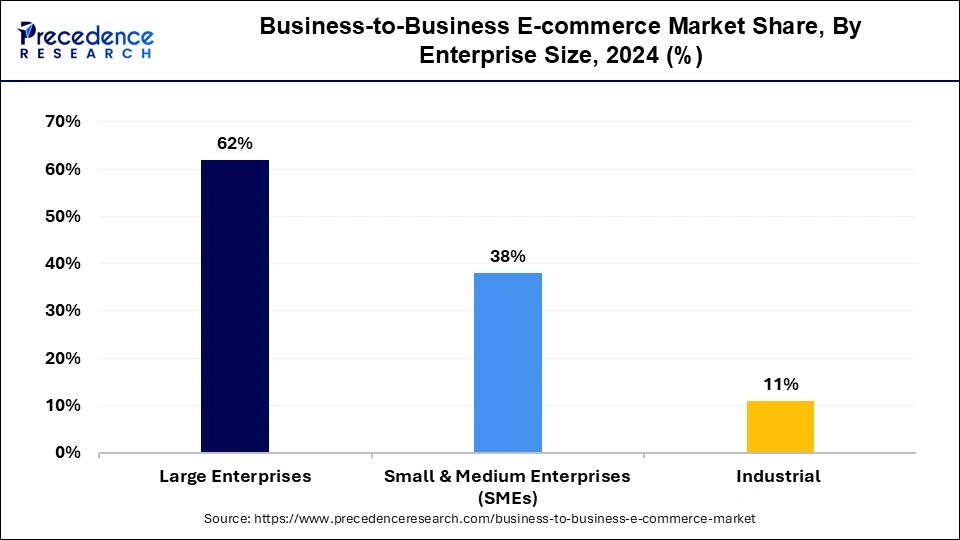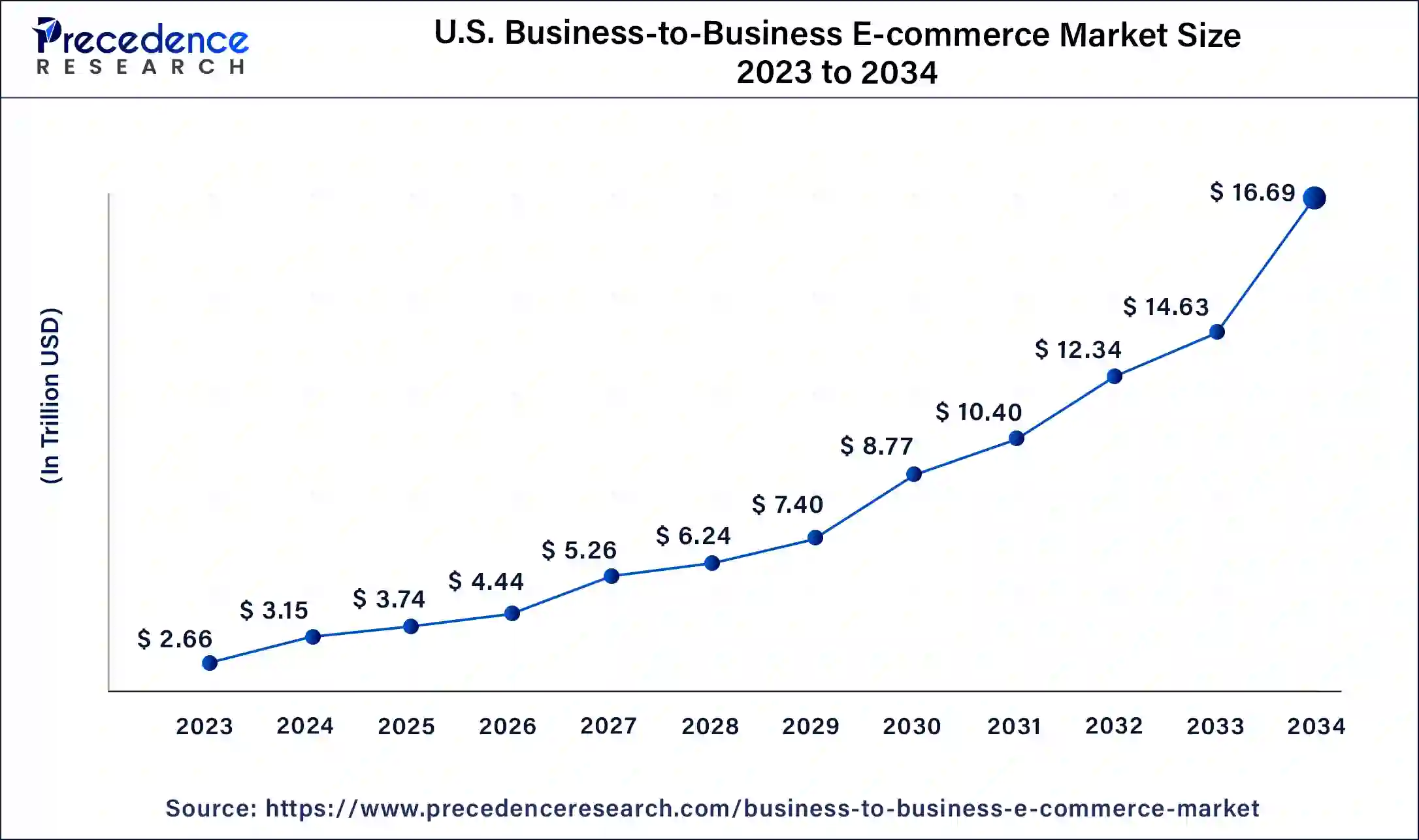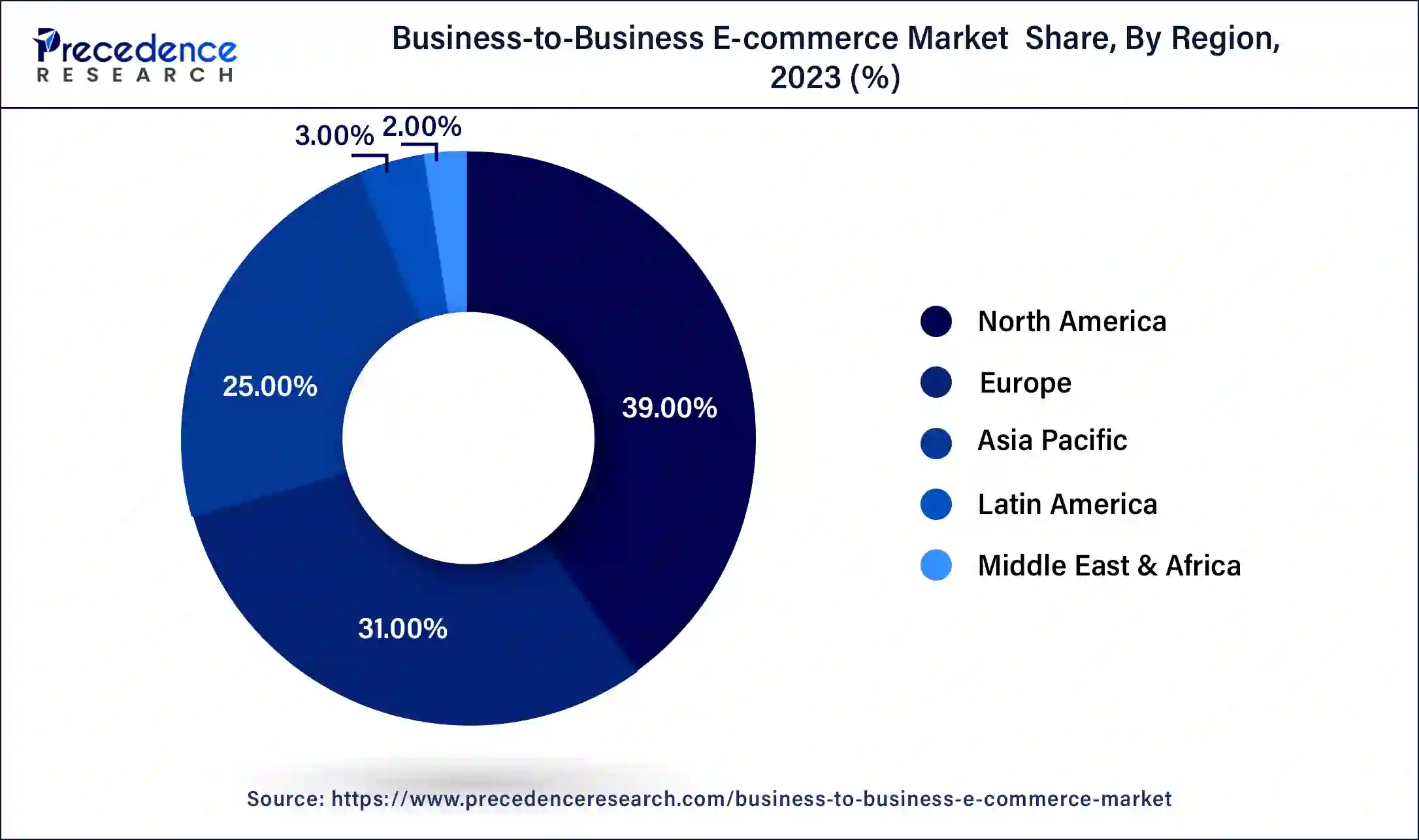What is Business-to-Business E-commerce Market Size?
The global business-to-business e-commerce market size accounted at USD 13.68 trillion in 2025 and is predicted to reach around USD 60.62 trillion by 2034, growing at a CAGR of 18.04% from 2025 to 2034.

Market Highlights
- North America contributed more than 39% of revenue share in 2024.
- Asia-Pacific is estimated to expand the fastest CAGR between 2025 and 2034.
- By deployment, the intermediary-oriented segment has held the largest market share of 42% in 2024.
- By deployment, the supplier-oriented segment is anticipated to grow at a remarkable CAGR of 20.1% between 2025 and 2034.
- By enterprise size, the large enterprise segment generated over 62% of the market share in 2024.
- By enterprise size, the small & medium enterprise segment is expected to expand at the fastest CAGR over the projected period.
- By application, the home & kitchen segment had the largest market share of 29% in 2024x`.
- By application, the consumer electronics segment is expected to expand at the fastest CAGR over the projected period.
Market Overview
The business-to-business e-commerce market involves online buying and selling goods and services between businesses. This digital platform streamlines transactions, procurement processes, and company collaboration, enabling efficient and transparent trade. B2B E-commerce platforms cater to various industries, facilitating bulk purchases, negotiation, and order fulfillment. The increasing adoption of digital technologies drives the market's growth, the need for cost-effective and streamlined procurement processes, and the demand for enhanced connectivity and collaboration within the global business ecosystem.
The business-to-business e-commerce market is characterized by platforms offering features like electronic data interchange (EDI), online catalogs, and payment solutions. The integration of advanced technologies, such as artificial intelligence and blockchain, further enhances transaction security and efficiency. The market's evolution responds to the escalating demand for digitization, scalability, and improved supply chain management in the business-to-business landscape.
- According to NuORDER by Lightspeed's annual State of B2B eCommerce Report released in April 2025, after record-high store closure predictions and ongoing economic uncertainty in 2025, brands are reconsidering their growth strategies for ensuring longevity, marking a pivotal shift from 6 years of single-channel strategies to a renewed focus on omnichannel.
- 41% of brands cited diversifying their sales channels to reach more customers as a top priority, and 57% of brands are highly focused on increasing and strengthening retail and customer relationships as a result.
- 43% of brands are working to build strong supplier partnerships for collaboration and flexibility, to expand their profit.
- Business-to-Business E-commerce Market Growth Factors
- Digital Transformation Catalyst: B2B e-commerce acts as a catalyst for digital transformation, enabling businesses to adapt to evolving market dynamics and enhance operational efficiency.
- Global Connectivity: B2B platforms facilitate global connectivity, allowing businesses to engage in cross-border transactions, expand market reach, and access a diverse supplier and customer base.
- Efficient Procurement Processes: The market streamlines procurement processes, offering features such as electronic data interchange (EDI) and online catalogs for efficient and transparent transactions.
- Technological Integration: Integration of advanced technologies, including artificial intelligence and blockchain, enhances security, transparency, and the overall effectiveness of B2B E-commerce transactions.
- Cost Savings and Scalability: B2B e-commerce provides cost-effective solutions, allowing businesses to achieve cost savings in procurement, logistics, and order fulfillment, while also offering scalability to accommodate growing business needs.
- Enhanced Collaboration: Platforms encourage collaboration by fostering communication between businesses, suppliers, and distributors, thereby fostering stronger business relationships.
- Supply Chain Optimization: The market contributes to supply chain optimization, offering real-time visibility into inventory, order status, and delivery, leading to improved logistics management.
- Flexible Payment Solutions: B2B e-commerce platforms offer flexible payment solutions, accommodating various payment methods and ensuring secure and efficient financial transactions.
- Rise of B2B Marketplaces: The emergence of B2B marketplaces provides a centralized platform for multiple suppliers, streamlining sourcing, and offering a diverse range of products and services.
- Customization and Personalization: Platforms prioritize customization and personalization, tailoring offerings to meet specific business requirements and providing a more tailored and efficient buying experience.
- Data-driven Decision Making: B2B e-commerce leverages data analytics to provide insights into purchasing patterns, market trends, and customer behavior, empowering businesses to make informed decisions.
- Integration with ERP Systems: Seamless integration with Enterprise Resource Planning (ERP) systems streamlines data flow, enhances operational efficiency, and ensures consistency across business processes.
- Sustainability Initiatives: B2B e-commerce platforms increasingly focus on sustainability, offering eco-friendly options and supporting businesses in their efforts to align with environmentally conscious practices.
- Evolving Market Dynamics: Continuous evolution in market dynamics, influenced by technological advancements, changing consumer behavior, and global economic shifts, presents ongoing opportunities for innovation and growth in the B2B e-commerce sector.
Business-to-Business E-commerce Market Trends
- Massive shift from offline to digital buying, as companies prefer online portals for faster ordering, transparent pricing, and streamlined procurement.
- Rapid rise of B2B marketplaces like Alibaba, Amazon Business, IndiaMART, and industry-specific platforms, offering bulk pricing and wide supplier networks.
- Growing use of AI and automation, helping businesses with smart product recommendations, automated reordering, demand forecasting, and real-time support.
- Increased adoption of digital payment systems, including UPI, corporate wallets, BNPL (Buy Now Pay Later), and secure B2B payment gateways.
- Personalized buying experiences, with platforms now offering customized catalogues, negotiated pricing, and contract-specific product lists for each buyer.
- Integration with ERP and supply chain systems, making it possible for companies to sync inventory, billing, logistics, and procurement directly with e-commerce portals.
Market Outlook
- Industry Growth Overview: As businesses move from offline to quicker digital platforms for purchases, the B2B e-commerce market is expanding. Online marketplaces provide better pricing simpler comparison shopping and automated ordering. Digital procurement is being used by more businesses to cut expenses and expedite supply chain decisions.
- Sustainability Trends:B2B platforms promote paperless transactions, digital invoices, and optimized logistics that cut fuel use. Many companies now prioritize eco-friendly suppliers available on online marketplaces. Improved digital tracking also helps businesses monitor and reduce their carbon footprint.
- Major Investors: Large e-commerce players, logistics companies, and tech giants such as Amazon Business, Alibaba, and industry-focused marketplaces are heavily investing in this space. Venture capital firms are also funding B2B startups offering smarter procurement tools. Investors focus on platforms that simplify bulk buying and integrate AI-driven supply management
Market Scope
| Report Coverage | Details |
| Market Size in 2025 | USD 13.68 Trillion |
| Market Size in 2026 | USD 16.21 Trillion |
| Market Size by 2034 | USD 60.62 Trillion |
| Growth Rate from 2025 to 2034 | CAGR of 18.04% |
| Largest Market | North America |
| Base Year | 2024 |
| Forecast Period | 2025 to 20324 |
| Segments Covered | Deployment, Enterprise Size, Application, and Region |
| Regions Covered | North America, Europe, Asia-Pacific, Latin America, and Middle East & Africa |
Market Dynamics
Drivers
Digital transformation demand and evolving customer expectations
The surge in the business-to-business e-commerce market is propelled by the dual forces of digital transformation demand and evolving customer expectations. As businesses increasingly recognize the imperative of digital transformation, B2B e-commerce emerges as a cornerstone for modernizing procurement processes and fostering operational efficiency. Companies seek digital solutions to streamline transactions, enhance collaboration, and gain real-time insights into their supply chains.
Simultaneously, evolving customer expectations play a pivotal role in driving demand. Businesses are witnessing a shift in B2B buyer behavior influenced by the seamless experiences provided by B2C e-commerce. Buyers now expect personalized, user-friendly interfaces, efficient order processing, and transparent communication. B2B e-commerce platforms that cater to these evolving expectations not only meet the demands of modern business practices but also position themselves as leaders in driving market demand amidst a transformative digital landscape.
Restraint
Security concerns and dependence on traditional relationships
The business-to-business e-commerce market faces restraints in the form of security concerns and lingering dependence on traditional relationships. Security remains a critical issue as businesses transition to digital platforms. Concerns about data breaches, cyber threats, and the protection of sensitive business information hinder the widespread adoption of B2B e-commerce. The reluctance to trust digital platforms with crucial data acts as a barrier, particularly for industries that prioritize confidentiality and data security.
Additionally, the B2B sector has historically relied on traditional relationships built on personal connections and established networks. The reluctance to shift away from these familiar and trusted methods poses a challenge for the rapid adoption of B2B e-commerce. Businesses may be hesitant to fully embrace digital platforms due to a preference for face-to-face interactions and established business relationships, slowing down the pace of transition and impacting the overall market demand for B2B e-commerce solutions.
Opportunity
Integration of AI & machine learning, blockchain for transparency and security
Integration of AI and machine learning in business-to-business e-commerce significantly enhances market demand by revolutionizing operational efficiency and decision-making processes. Machine learning algorithms offer personalized recommendations, improving user experiences and increasing engagement on B2B platforms. This intelligent automation fosters seamless transactions, reducing errors and enhancing overall productivity.
Blockchain integration further propels market demand by addressing critical concerns of transparency and security. Blockchain ensures the immutability of transaction records, creating a transparent and auditable ledger. This technology enhances trust among B2B stakeholders, as it eliminates the risk of fraud and provides a secure environment for sensitive data. As businesses prioritize secure and transparent transactions, the incorporation of blockchain in B2B E-commerce becomes a vital driver, fostering a heightened demand for platforms that prioritize cutting-edge technologies to meet the evolving needs of the business landscape.
Trends, Technology, and Strategic Insights
|
Category |
Focus |
Trends/Innovations |
Market Impact |
|
Platform Development |
B2B marketplaces & portals |
AI personalization, mobile-first, cloud platforms |
Improves UX, drives engagement, enables global scalability |
|
Payments & Transactions |
Secure payments & invoicing |
Real-time payments, digital wallets, blockchain |
Faster transactions, reduced fraud, smooth cross-border payments |
|
Supply Chain & Logistics |
Warehousing & delivery |
IoT tracking, automated fulfillment, predictive inventory |
Reduces delays, lowers costs, improves order accuracy |
|
CRM & Client Management |
B2B client acquisition & retention |
AI-driven CRM, lead scoring, omnichannel support |
Strengthens relationships, increases repeat business |
|
Compliance & Regulations |
Trade, data privacy, taxes |
GDPR, VAT, export-import rules, KYC |
Minimizes legal risk, ensures smooth international operations |
|
Data Analytics |
Market trends & buyer behavior |
Predictive analytics, AI insights |
Supports strategic decisions, optimizes offerings |
|
Security & Fraud |
Data protection |
Encryption, multi-factor authentication, AI detection |
Protects data, builds trust, reduces financial risk |
Segment Insights
Deployment Insights
According to the deployment, the Intermediary-oriented segment held a 42% revenue share in 2024. Intermediary-oriented B2B E-commerce involves platforms that act as intermediaries or middlemen, connecting multiple buyers and suppliers. These platforms facilitate transactions, negotiations, and collaboration among businesses. The trend in intermediary-oriented deployment includes the rise of B2B marketplaces that bring together a diverse range of suppliers and buyers on a centralized platform, fostering increased visibility, competition, and streamlined transactions.
The supplier-oriented segment is anticipated to expand at a significant CAGR of 20.1% during the projected period. Supplier-oriented B2B e-commerce platforms prioritize the needs and offerings of individual suppliers. These platforms empower suppliers to showcase their products or services directly to potential buyers, often allowing for customized storefronts. The trend in supplier-oriented deployment centers around enhancing supplier visibility, providing tools for effective product showcasing, and offering features that enable suppliers to manage their B2B relationships more efficiently.
Enterprise Size Insights
Based on the enterprise size, the large enterprise segment held the largest market share of 62% in 2024. Large Enterprises in the business-to-business e-commerce market exhibit a robust integration of sophisticated platforms to manage extensive procurement operations. Trends among large enterprises include the deployment of comprehensive ERP integrations, blockchain for enhanced transparency, and AI-driven analytics for strategic decision-making. These enterprises focus on creating seamless, end-to-end digital ecosystems to optimize complex supply chain networks, ensuring efficiency, scalability, and compliance with evolving industry standards.

On the other hand, the small & medium enterprise segment is projected to grow at the fastest rate over the projected period. Small and Medium Enterprises in the business-to-business e-commerce market represent a growing segment leveraging digital platforms for streamlined transactions. SMEs benefit from cost-effective procurement, access to a wider supplier network, and simplified order fulfillment. Trends indicate increased adoption of cloud-based B2B solutions, personalized user experiences, and AI-driven tools tailored to the specific needs and scale of SMEs, fostering their competitiveness in the digital marketplace.
Application Insights
In 2024, the home & kitchen segment had the highest market share of 29% on the basis of the end user. In the business-to-business e-commerce market, home & kitchen applications witness a surge in demand. Businesses within this sector leverage online platforms for bulk procurement of kitchenware, appliances, and home essentials. The trend leans towards personalized and sustainable products, and B2B platforms cater to these preferences, offering a diverse range of items. The convenience of digital transactions and the ability to connect with a myriad of suppliers contribute to the flourishing trend of home & kitchen B2B e-commerce.
The consumer electronics segment is anticipated to expand at the fastest rate over the projected period. B2B e-commerce in consumer electronics experiences dynamic growth with businesses seeking efficient ways to source electronic components and devices. The trend emphasizes cutting-edge technologies, such as AI-powered devices and sustainable electronics. B2B platforms become hubs for businesses to explore the latest innovations, negotiate deals, and ensure a streamlined supply chain for consumer electronics. The adoption of these trends reflects the industry's commitment to staying ahead in a rapidly evolving tech landscape through B2B e-commerce solutions.
Regional Insights
U.S. Business-to-Business E-commerce Market Size and Growth 2025 to 2034
The U.S. business-to-business e-commerce market size is valued at USD 3.74 trillion in 2025 and is expected to reach USD 16.69 trillion by 2034, growing at a CAGR of 18.14% from 2025 to 2034.

North America has held the largest revenue share of 39% in 2024. In North America, the B2B e-commerce market is characterized by a robust adoption of digital technologies. The region exhibits a mature and sophisticated B2B e-commerce landscape, driven by established businesses embracing online platforms for procurement. Key trends include a focus on AI and machine learning integration, ensuring operational efficiency, and a surge in cross-industry collaboration through B2B marketplaces. The presence of major tech hubs fosters continuous innovation, making North America a dynamic hub for B2B E-commerce evolution.

Asia-Pacific is estimated to observe the fastest expansion. Asia-Pacific business-to-business e-commerce market is experiencing exponential growth, fueled by the region's burgeoning digital economy. Rapid industrialization, coupled with a large and diverse business landscape, propels the adoption of B2B E-commerce platforms. Key trends include an emphasis on mobile-first solutions, catering to the region's mobile-savvy businesses. Cross-border trade expansion is notable, driven by the growing connectivity among Asia-Pacific countries. The influence of emerging markets and the proactive adoption of advanced technologies position Asia-Pacific as a vital player shaping the future of B2B E-commerce.
- On May 6, 2025, Genie Business collaborated with Savabuy, a fast-growing B2B e-commerce platform enabling Sri Lankan entrepreneurs and businesses to source products directly from China. The Genie Business powers Savabuy's in-app transactions with its secure and scalable Internet Payment Gateway (IPG) through this partnership. Source: dialog.lk
In Europe, the business-to-business e-commerce market showcases a harmonious blend of traditional business practices and digital innovation. The region witnesses a steady transition towards online procurement, with a focus on enhancing user experiences and ensuring compliance with evolving regulations. Key trends include a growing emphasis on sustainability in B2B transactions, coupled with the integration of advanced technologies like AI. Europe's diverse and interconnected business landscape continues to drive the evolution of B2B E-commerce towards more efficient and sustainable practices.
Business-to-Business E-commerce Market Companies
- Alibaba Group Holding Limited
- Amazon.com, Inc.
- Tencent Holdings Limited
- JD.com, Inc.
- Rakuten, Inc.
- eBay Inc.
- Walmart Inc.
- Oracle Corporation
- IBM Corporation
- SAP SE
- Mercateo AG
- ThomasNet
- Global Sources Ltd.
- TradeIndia
- ThomasNet
Recent Developments
- On May 6, 2025, Albertsons Companies, Inc., announced expansion of its business eCommerce platform to over 2,000 stores, which include Star Market,?Albertsons,?Safeway, Jewel-Osco,?ACME, Shaw's, Vons,?Pavilions,?Tom Thumb, and?Randalls. A seamless way to order essential food and breakroom supplies, along with cleaning and paper products from their trusted local grocer, is offered to all-sized businesses through this platform. Source: albertsonscompanies.com
- On May 6, 2025, DHL Supply Chain acquired e-commerce and retail logistics specialist IDS Fulfillment to advance its offering to small and midsize companies. The acquisition adds over 1.3 million square feet of multi-customer warehouse and distribution space strategically located across the U.S. Source: group.dhl.com
- In April 2025, TikTok announced the launch of TikTok Shop, its e-commerce platform, in Japan in?June 2025. The company is slated to recruit sellers and will offer a platform for users to sell products through livestreams, earning commissions on sales. This move I followed step from TikTok's recent expansion into Europe, and is part of its strategy to diversify its business amid regulatory challenges in the US. Source: timesofindia.indiatimes.com
- In 2023, Walmart Commerce Technologies and Salesforce collaborated to empower retailers utilizing Salesforce Commerce Cloud. This partnership enables retailers to integrate Walmart's store fulfillment technologies and local delivery services seamlessly, providing customers with convenient pickup and delivery options, enhancing the overall shopping experience on the Salesforce Commerce Cloud platform.
- In 2021, Newegg Commerce, Inc. collaborated with Affirm, Inc., a payment network, to offer customers on Newegg.com flexible payment options like pay-over-time. This partnership enables customers to make purchases with Affirm, dividing payments into manageable installments without hidden or late fees, enhancing the affordability and convenience of transactions on the platform.
Segments Covered in the Report
By Deployment
- Supplier-Oriented
- Buyer-Oriented
- Intermediary-Oriented
By Enterprise Size
- Small & Medium Enterprise
- Large Enterprise
By Application
- Home & Kitchen
- Consumer Electronics
- Industrial & Science
- Healthcare
- Clothing
- Beauty & Personal Care
- Sports Apparel
- Books & Stationery
- Automotive
- Others
By Region
- North America
- Europe
- Asia-Pacific
- Latin America
- Middle East and Africa
For inquiries regarding discounts, bulk purchases, or customization requests, please contact us at sales@precedenceresearch.com
Frequently Asked Questions
Ask For Sample
No cookie-cutter, only authentic analysis – take the 1st step to become a Precedence Research client




 sales@precedenceresearch.com
sales@precedenceresearch.com
 +1 804-441-9344
+1 804-441-9344